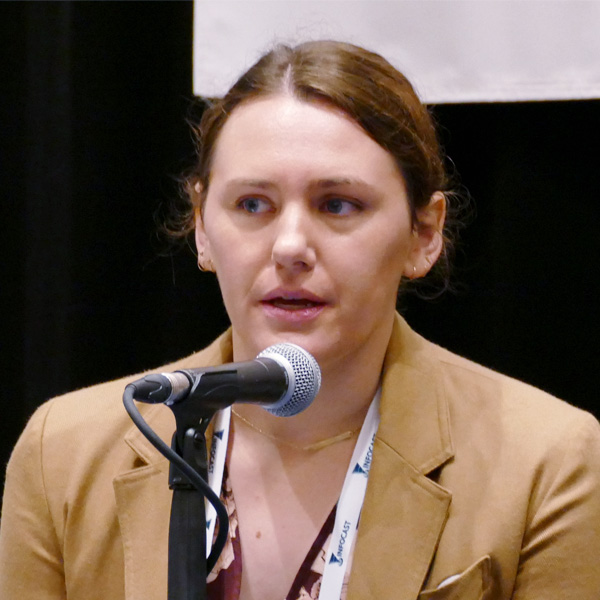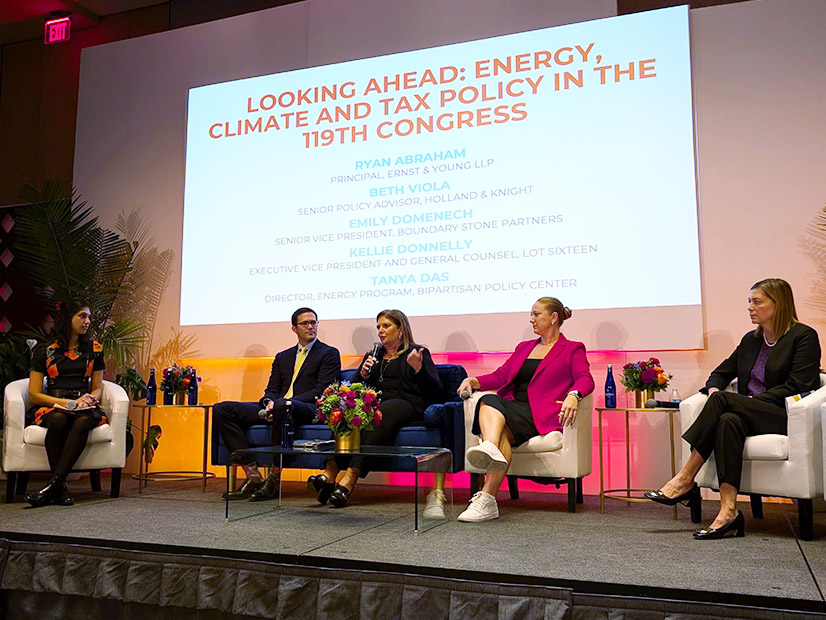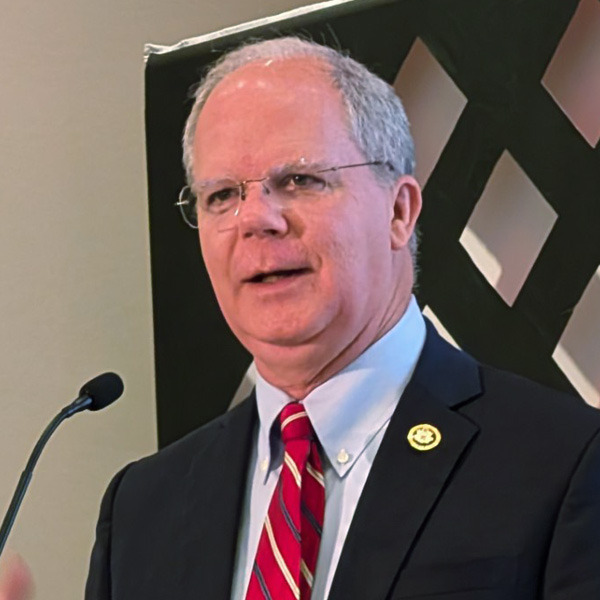PJM Proposes Reopening Discussion of Storage as a Transmission Asset
VALLEY FORGE, Pa. — About four years after PJM stakeholders shelved deliberations on rules around how battery storage can be used to address transmission constraints, PJM Director of Stakeholder Affairs Dave Anders presented a first read on reopening the topic with a refreshed problem statement and issue charge.
Anders framed the issue charge as the second phase in developing market rules for battery storage, following on the implementation of rules for how storage can participate in the markets. A possible third phase could consider how a battery installation could serve simultaneously as transmission and a market asset. But PJM’s Becky Carroll said staff prefer to develop clear rules on the market and transmission sides before trying to create a dual-use structure.
“It’s not a never, it’s just not right now for the dual-use piece of it,” she said.
Vistra’s Erik Heinle questioned whether stakeholders should embark on developing a new structure for a class of transmission assets while tackling several other major efforts. He suggested instead waiting six months before initiating the work.
Anders said staff also was concerned about inundating stakeholders with additional meetings, which played into the issue charge designating the work to the Operating Committee.
Tom Hyzinski, of the GT Power Group, said the classic use case could be a substation where a transformer failure could lead to excessive loading on other facilities. Rather than installing an additional transformer, he said a battery could alleviate the loading while potentially being cheaper and easier to install. He agreed that transmission rules should be developed before considering how that same battery could participate in the markets.
Greg Poulos, executive director of the Consumer Advocates of the PJM States (CAPS), said there are advocates who believe it should be a priority to enable dual-use storage as quickly as possible. He said the possible elimination of energy efficiency as a resource class and de-rating of demand response have limited the ability for load to respond to market signals and that increased storage could present an ability to mitigate capacity prices. Some advocates may seek an amendment to PJM’s issue charge or an alternative with dual use included.
Exelon’s Alex Stern said he believes it’s best to take “crawl before we walk approach” to avoid consideration of storage as a transmission asset (SATA) being derailed by arguments over dual use.
Bowring said market-oriented assets, including storage and generation, can be used as transmission, such as when PJM dispatches them to provide voltage support. He said the capability to install SATA could be practically limited to transmission owners.
The dual-use concept presents even greater concerns, Bowring said, by creating an “impossible task” of determining if one side is subsidizing the other, either markets or transmission with a regulated return.
LS Power Issue Charges on Accreditation Transparency, Unit-specific Performance
LS Power presented two issue charges focused on PJM’s marginal effective load-carrying capability (ELCC) accreditation framework. One would focus on making the calculations more transparent and replicable for market participants. The other would aim to replace class accreditation with adjustments for each unit with unit-specific ELCC ratings. (See FERC Approves 1st PJM Proposal out of CIFP.)
Vice President of Wholesale Market Policy Dan Pierpont said a more comprehensive understanding of how ELCC values are determined and how they influence final unit accreditations could allow generation owners to make investments that would improve unit capacity.
Pierpont said the issue charge seeks a way for generation owners to validate their accreditation values, understand how physical or managerial changes to a unit would affect accreditation and a set date for PJM to lock in changes to ELCC values to provide more market certainty ahead of auctions.
“The complexity of the marginal ELCC methodology remains an important determining factor in the ability of PJM’s capacity market to send transparent price signals and attract investment where needed,” the transparency issue charge states. “To make that determination, significantly more data and analytical transparency is needed.”
The document would hold discussion of alternative accreditation frameworks and a sub-annual capacity market to be out-of-scope. It targets having any changes approved to be implemented for the 2028/29 Base Residual Auction (BRA), scheduled for December 2025.
Susan Bruce, representing the PJM Industrial Customer Coalition (PJM ICC), said more transparency around ELCC could be beneficial for all market participants and suggested an amendment to provide more data access for all members. LS Power Director of Project Development Tom Hoatson said the company would be open to such an amendment to the issue charge, as long as market sensitive information is protected.
The unit-specific ELCC issue charge seeks to expand the data considered in the ELCC unit-specific performance adjustment to allow accreditation to reflect any changes made that could improve performance. Pierpont said the adjustment considers a narrow number of hours in which load drop occurred, which in practice results in accreditation values weighted toward performance during the 2014 Polar Vortex and weather and load during winter storms in 1994. Investments made in resources since that event would have minimal impact on how that unit’s potential performance is evaluated compared to the rest of the resource class, he said.
The problem statement argues the issue is twofold: The incentive for generators to make investments to improve performance could be limited if accreditation values would remain static, and maintenance costs may be ignored if no capacity derate is likely. The issue charge targets a FERC filing in the first quarter of 2025.
The issue charge focuses on how much historical data PJM includes in its performance, load and weather data; the unit-specific performance adjustment and possible use of a unit-specific ELCC accreditation; how ELCC class average values are applied to new resources; and how transmission headroom factors into ELCC values.
PJM CEO Manu Asthana said it takes a long time for performance improvements to be reflected in resource accreditation and it’s a valid inquiry to look at how investments can be accounted for more quickly.
LS Power Senior Vice President of Wholesale Market Policy Marji Philips said if a turbine fails during a performance assessment interval (PAI) and the generation owner replaces the equipment and makes changes to avoid that happening again, that event can lead to diminished accreditation for years.
“That bad experience during a PAI haunts us for years,” she said.
The PJM Public Power Coalition’s Carl Johnson said the ELCC construct can be improved upon, but any stakeholder efforts must be approached cautiously to ensure they do not conflict with changes likely to be made through the second phase of PJM’s capacity market redesign.
Vitol’s Jason Barker said it’s logical to reflect capital expenditures, but the issue charge seems focused on speeding accreditation for thermal resources without addressing the increased accreditation for renewables resources that could be unlocked through a sub-annual market design. He also questioned whether it’s reasonable to expect changes to the ELCC structure could be accomplished within the envisioned 4.5-month timeline.
Independent Market Monitor Joe Bowring said stakeholders discussed related issues at length during the Critical Issue Fast Path (CIFP) process last year, and he said membership is capable of acting in a disciplined and focused way.
Poulos said the compressed capacity auction schedules makes the implementation timeline especially important and recommended prioritizing working areas to ensure changes can be in place for the earliest auction possible.
Stakeholders Endorse Creation of Electric Gas Coordination Subcommittee
The MRC endorsed the sunsetting of the Electric Gas Coordination Senior Task Force (EGCSTF), to be replaced with a new Electric Gas Coordination Subcommittee (EGCS), which is intended to have a wider scope and be more flexible in the topics it can address. (See “PJM Proposes Sunsetting Electric Gas Coordination Senior Task Force,” PJM MRC/MC Briefs: Aug. 21, 2024.)
The MRC voted in June to endorse part of a proposal drafted by the EGCSTF, greenlighting changes to the day-ahead energy market commitment cycle to align with daily gas pipeline nomination deadlines. Stakeholders rejected a second component that would ask generators to voluntarily notify PJM of whether they have procured fuel necessary to meet their commitments or intend to do so. (See “Stakeholders Endorse Revised Proposal to Align Energy, Gas Schedules,” PJM MRC/MC Briefs: June 27, 2024.)
A subcommittee would allow a more long-term focus on harmonizing aspects of PJM’s markets with how gas pipelines are operated and consider revisions to a broader swath of PJM’s market rules.
The draft charter states that the responsibilities and scope of the subcommittee include reviewing market and operational conflicts between the electric and gas sectors, assessing and updating participants on state and federal initiatives affecting gas-electric coordination, and “[recommending] necessary enhancements to PJM rules, systems and procedures which can improve grid reliability, efficient market operations, and greater availability and flexibility of natural gas-fired generating resources.”
Paul Sotkiewicz, president of E-Cubed Policy Associates, questioned how it can be ensured that stakeholder efforts to improve market rules around gas generation do not become siloed between different working groups. Anders said part of subcommittee’s charge would be to keep tabs on those efforts with regular updates.
“The important part is to keep the communication lines open … and frankly I think that’s one of the things this new subcommittee can do, to make sure we’re thinking across the whole horizon,” Anders said.
Hourly Notification Times in Day-ahead Market Endorsed
Stakeholders endorsed a proposal to add hourly notification times to the day-ahead (DA) energy market, expanding the capability from the real-time (RT) market. (See “Hourly Notification Times,” PJM MRC/MC Briefs: Aug. 21, 2024.)
PJM’s Joseph Ciabattoni told the MRC that generators are limited to daily notification in the DA market. But reserve price formation market changes have increased the importance of notification times for determining the eligibility and capability of offline resources to be committed as non-synchronized and secondary reserves.
Sotkiewicz said notification times are an important factor for gas resources and more discussion is needed to continue to refine how they are committed.
PJM Proposes Elimination of Two Interface Pricing Models
PJM’s Brian Chmielewski presented a first read on tariff revisions to remove the high/low and marginal-cost proxy interface pricing options. (See “PJM Proposes Elimination of 2 Interface Pricing Options,” PJM MIC Briefs: Aug. 7, 2024.)
Both were designed for pricing imports and exports with neighboring nonmarket regions. But they have gone unused since July 2019, when Duke Energy Progress terminated its dynamic interface, which used marginal-cost proxy pricing. Chmielewski said a nodal aggregate pricing approach has since been implemented, which PJM believes creates accurate price signals based on other interfaces.
The proposal is set to be voted on by the MRC on Oct. 30 and the MC on Nov. 21 and to be filed at FERC in December.
First Read on Increased Review of Credit Risk for Bilateral Capacity Transactions
PJM presented a first read on a proposal to strengthen its ability to collect capacity performance (CP) penalties from market participants who have bilaterally sold their capacity rights and revenues.
Assistant General Counsel Eric Scherling said bilateral transactions separate the payments received by the buyer from the performance obligations held by the seller, which can present issues if the seller does not have proper credit or revenues to cover any possible performance penalties.
PJM would conduct a credit review of bilateral capacity transactions before they can be completed and both parties’ creditworthiness and the impact the transaction might be considered before PJM signs off. Transactions where both the buyer and seller have external investment grade ratings, and the total notional value of the transaction is less than their unsecured credit allowance would be considered approved unless PJM states otherwise.
If PJM is notified of a transaction before 1 p.m., it would complete the credit review by the end of the next business day; if the notification came after 1 p.m., PJM would have two days to complete the review.
PJM’s Gwen Kelly said the intent is not to create any changes to the credit risk evaluation, but to provide more visibility into the transactions before they’re created to allow proactive, rather than reactive, actions to be taken if issues are identified.


